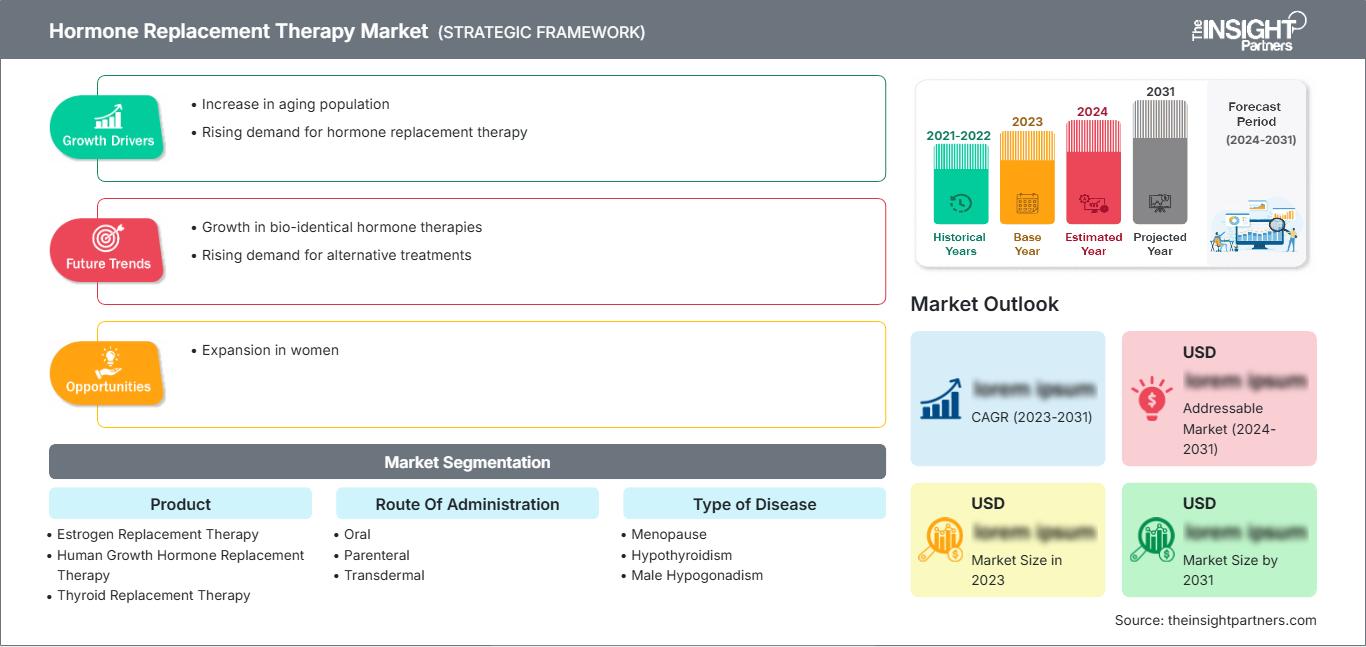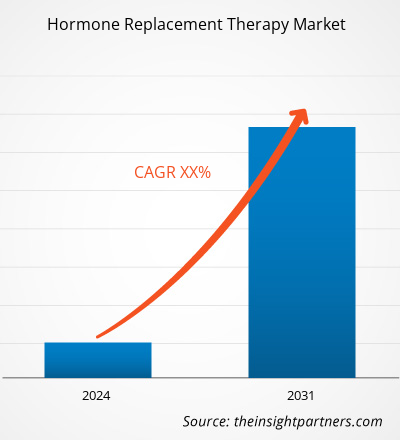Si prevede che il mercato della terapia ormonale sostitutiva (TOS) raggiungerà i 35,91 miliardi di dollari entro il 2031. Si prevede che il mercato registrerà un CAGR del 6,0% nel periodo 2025-2031.
La domanda globale di terapia ormonale sostitutiva (TOS) è in costante aumento a causa di fattori quali la crescente prevalenza di disturbi ormonali, la crescente consapevolezza delle carenze ormonali e i miglioramenti nelle formulazioni della TOS. Grazie ai suoi evidenti vantaggi in termini di sicurezza ed efficacia, la terapia ormonale sostitutiva bioidentica (BHRT) sta diventando più popolare degli ormoni sintetici. Poiché deriva da fonti naturali, si ritiene che la BHRT assomigli maggiormente agli ormoni prodotti naturalmente dall'organismo.
Le aziende farmaceutiche stanno investendo nello sviluppo di nuove formulazioni per la terapia ormonale, tra cui cerotti transdermici, gel, creme e impianti sottocutanei, per migliorare la praticità, la compliance e la sicurezza dei pazienti. Questo fattore stimola la crescita del mercato della terapia ormonale sostitutiva. Nell'agosto 2023, la Food and Drug Administration (FDA) ha approvato la domanda di autorizzazione all'immissione in commercio (abbreviata) di ANI Pharmaceuticals per il gel di estradiolo allo 0,1%. Il farmaco di riferimento Divigel è una terapia ormonale a base di estrogeni utilizzata per il trattamento dei sintomi vasomotori da moderati a gravi associati alla menopausa. La forma generica di Divigel è il gel di estradiolo allo 0,1%.
Fattori di crescita:
L'ampia gamma di applicazioni stimola la crescita del mercato della terapia ormonale sostitutiva
La terapia ormonale sostitutiva viene prescritta per trattare i sintomi della menopausa, il deficit dell'ormone della crescita, ecc., che possono avere un profondo impatto sulla vita. Milioni di donne utilizzano la terapia ormonale sostitutiva, a volte per lunghi periodi. La terapia ormonale sostitutiva può prevenire l'osteoporosi e migliorare la qualità della vita in diversi modi. Secondo l'Oregon Health & Science University, il deficit dell'ormone della crescita (GHD) non è comune e colpisce circa 50.000 adulti negli Stati Uniti e circa un bambino su 4.000-6.000. Pertanto, un crescente utilizzo della terapia, unito alla crescente prevalenza di vari disturbi ormonali, guida la crescita del mercato dei trattamenti di terapia ormonale sostitutiva.
Contenimento:
L'elevato costo dei farmaci ostacola la crescita del mercato della terapia ormonale sostitutiva
Il costo dei prodotti per la terapia ormonale sostitutiva (TOS) è relativamente elevato. Ad esempio, il prezzo delle prescrizioni di terapia ormonale sostitutiva orale varia da 130 a 240 dollari al mese (ovvero, da 1.560 a 2.440 dollari all'anno), secondo il Menopause Center. L'elevato costo impedisce l'uso regolare di questi prodotti, limitando la crescita del mercato della terapia ormonale sostitutiva.
Riceverai la personalizzazione gratuita di qualsiasi report, incluse parti di questo report, analisi a livello nazionale, pacchetto dati Excel e potrai usufruire di fantastiche offerte e sconti per start-up e università.
Mercato della terapia ormonale sostitutiva: approfondimenti strategici

-
Scopri le principali tendenze di mercato di questo rapporto.Questo campione GRATUITO includerà analisi dei dati, che spaziano dalle tendenze di mercato alle stime e alle previsioni.
Segmentazione e ambito del report:
L'analisi di mercato della terapia ormonale sostitutiva è stata condotta prendendo in considerazione i seguenti segmenti: terapia, applicazione, via di somministrazione e utente finale.
In base alla terapia, il mercato della terapia ormonale sostitutiva è segmentato in terapia ormonale sostitutiva con estrogeni, terapia ormonale sostitutiva con ormone della crescita, terapia ormonale sostitutiva con ormone tiroideo, terapia ormonale sostitutiva con testosterone e altre. Il segmento della terapia ormonale sostitutiva con estrogeni ha detenuto la quota di mercato maggiore nel 2023.
Il mercato della terapia ormonale sostitutiva, per applicazione, è suddiviso in menopausa, deficit dell'ormone della crescita (GH), ipotiroidismo, ipogonadismo e altri. Il segmento della menopausa ha detenuto la quota di mercato più ampia della terapia ormonale sostitutiva nel 2023 e si prevede che registrerà il CAGR più elevato durante il periodo di previsione.
Analisi regionale:
In termini di regione, l'ambito del rapporto di mercato sulla terapia ormonale sostitutiva include Nord America, Europa, Asia-Pacifico, America meridionale e centrale, Medio Oriente e Africa. Nel 2023, il Nord America deteneva la quota di mercato maggiore. La crescente adozione delle tecnologie più recenti, la crescente prevalenza di disturbi ormonali, l'adozione precoce di nuovi prodotti e la presenza di attori chiave del mercato contribuiscono alla crescita del mercato della terapia ormonale sostitutiva in Nord America. Nel giugno 2023, NGENLA (somatrogon-ghla), un analogo dell'ormone della crescita umano a somministrazione settimanale, è stato approvato dalla Food and Drug Administration (FDA) statunitense per il trattamento di pazienti pediatrici di età pari o superiore a tre anni affetti da deficit di crescita causato da insufficiente secrezione di ormone della crescita endogeno, secondo una dichiarazione rilasciata da Pfizer Inc. e OPKO Health Inc.
Inoltre, una maggiore attenzione all'accesso a cure personalizzate di qualità e al rafforzamento delle soluzioni sanitarie creerebbe significative opportunità per il mercato della terapia ormonale sostitutiva durante il periodo di previsione. Nel maggio 2023, una delle più grandi reti di cliniche per la terapia ormonale sostitutiva in Texas, Hormones by Design, è stata acquisita da Forum Health, LLC, la prima rete nazionale di fornitori di medicina integrativa e funzionale.
Approfondimenti regionali sul mercato della terapia ormonale sostitutiva
Le tendenze regionali e i fattori che influenzano il mercato della terapia ormonale sostitutiva durante il periodo di previsione sono stati ampiamente spiegati dagli analisti di The Insight Partners. Questa sezione illustra anche i segmenti e l'area geografica del mercato della terapia ormonale sostitutiva in Nord America, Europa, Asia-Pacifico, Medio Oriente e Africa, America Meridionale e Centrale.
Ambito del rapporto di mercato sulla terapia ormonale sostitutiva
| Attributo del report | Dettagli |
|---|---|
| Dimensioni del mercato nel 2024 | XX miliardi di dollari USA |
| Dimensioni del mercato entro il 2031 | 35,91 miliardi di dollari USA |
| CAGR globale (2025 - 2031) | 6,0% |
| Dati storici | 2021-2023 |
| Periodo di previsione | 2025-2031 |
| Segmenti coperti |
Per prodotto
|
| Regioni e paesi coperti |
America del Nord
|
| Leader di mercato e profili aziendali chiave |
|
Densità degli operatori del mercato della terapia ormonale sostitutiva: comprendere il suo impatto sulle dinamiche aziendali
Il mercato della terapia ormonale sostitutiva è in rapida crescita, trainato dalla crescente domanda da parte degli utenti finali, dovuta a fattori quali l'evoluzione delle preferenze dei consumatori, i progressi tecnologici e una maggiore consapevolezza dei benefici del prodotto. Con l'aumento della domanda, le aziende stanno ampliando la propria offerta, innovando per soddisfare le esigenze dei consumatori e sfruttando le tendenze emergenti, alimentando ulteriormente la crescita del mercato.

- Ottieni una panoramica dei principali attori del mercato della terapia ormonale sostitutiva
Sviluppi del settore e opportunità future:
Di seguito sono elencati gli sviluppi strategici dei principali attori operanti nel mercato della terapia ormonale sostitutiva, come riportato nei comunicati stampa aziendali:
- Nel gennaio 2024, Ascendis Pharma A/S (Danimarca) e Vector Pharma FZCO (Vector) hanno raggiunto un accordo di distribuzione esclusiva per la commercializzazione di Yorvipath e Skytrofa nei paesi del Consiglio di Cooperazione del Golfo (GCC), ovvero Arabia Saudita, Emirati Arabi Uniti, Kuwait, Oman, Qatar e Bahrein. In base alle condizioni di questo accordo di distribuzione esclusiva, Vector utilizzerà la propria esperienza di vendita e marketing per fornire ai pazienti dei paesi del GCC Yorvipath e Skytrofa per il trattamento dell'ipoparatiroidismo negli adulti, nel caso di Yorvipath, e del deficit dell'ormone della crescita (GHD) pediatrico, nel caso di Skytrofa.
Panorama competitivo e aziende chiave:
Astrazeneca; Pfizer Inc.; Novartis AG; Abbott; Tolmar Inc; Par Pharmaceutical; Mayne Pharma Group Limited; Novo Nordisk A/S; Eli Lily and Company; e Noven Pharmaceuticals, Inc. sono tra le aziende di spicco descritte nel rapporto di mercato sulla terapia ormonale sostitutiva. Queste aziende si concentrano sullo sviluppo di nuove tecnologie, sull'aggiornamento dei prodotti esistenti e sull'espansione della loro presenza geografica per soddisfare la crescente domanda dei consumatori in tutto il mondo.
- Analisi storica (2 anni), anno base, previsione (7 anni) con CAGR
- Analisi PEST e SWOT
- Valore/volume delle dimensioni del mercato - Globale, Regionale, Nazionale
- Industria e panorama competitivo
- Set di dati Excel
Report recenti
Testimonianze
Motivo dell'acquisto
- Processo decisionale informato
- Comprensione delle dinamiche di mercato
- Analisi competitiva
- Analisi dei clienti
- Previsioni di mercato
- Mitigazione del rischio
- Pianificazione strategica
- Giustificazione degli investimenti
- Identificazione dei mercati emergenti
- Miglioramento delle strategie di marketing
- Aumento dell'efficienza operativa
- Allineamento alle tendenze normative






















 Ottieni un campione gratuito per - Mercato della terapia ormonale sostitutiva
Ottieni un campione gratuito per - Mercato della terapia ormonale sostitutiva